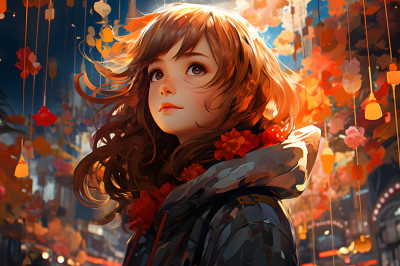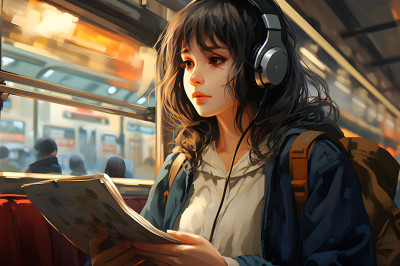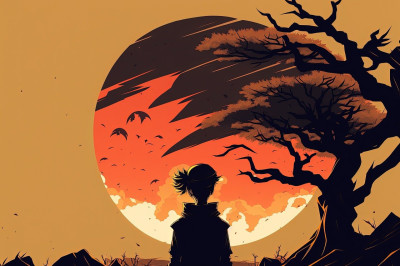The Roots of Anime: From Astro Boy to Global Phenomenon
The anime industry's evolution began in the early 20th century, but it was the 1963 debut of Osamu Tezuka's "Astro Boy" that marked the birth of the modern style of Japanese animation. This series set the stage for the growth of anime, with its distinctive art style and storytelling techniques. In the following decades, anime expanded through television series, films, and the burgeoning home video market, which allowed fans to collect and watch their favorite series with ease.
The Impact of Technological Advancements
As technology advanced, so did anime. The transition from hand-drawn cel animation to digital processes in the late 1990s and early 2000s revolutionized the industry. This shift not only improved the efficiency of production but also enhanced the visual quality of anime. High-definition animation and computer-generated imagery (CGI) became commonplace, allowing for more complex and dynamic visuals.
The Rise of Anime Subcultures
Anime began to foster various subcultures as it grew in popularity. Series like "Mobile Suit Gundam" spawned the mecha genre, which became a cornerstone of anime, influencing countless other series and even the toy industry. Similarly, magical girl and high school romance genres developed dedicated fanbases, each with their own unique tropes and conventions.
Globalization and the Anime Boom
The 1990s and early 2000s saw a significant increase in anime's global reach. With the advent of the internet and the rise of anime licensing abroad, series like "Dragon Ball Z," "Sailor Moon," and "Naruto" became international hits. This period marked the beginning of anime's transformation from a niche interest to a significant component of global pop culture.
Streaming Services and Accessibility
The introduction of streaming services has arguably been the most significant shift in the anime industry in recent years. Platforms like Crunchyroll, Netflix, and Amazon Prime have made anime more accessible than ever before, offering vast libraries of content that can be enjoyed by viewers around the world. This ease of access has led to an unprecedented level of exposure and growth for the industry.
Changing Demographics and Diverse Storytelling
Anime's audience has become increasingly diverse, leading to a broader range of storytelling themes and genres. Shows now tackle a variety of subjects, from the complexities of adult life to nuanced social issues, reflecting the changing demographics of its viewers. This diversification has also led to anime's increased recognition as a legitimate form of art and storytelling.
The Influence of Fan Communities
Fan communities have played a crucial role in the evolution of the anime industry. Through fan-subbed content, conventions, and fan art, these communities have not only supported the industry but also influenced the types of series that are produced. The feedback loop between creators and fans has become a dynamic part of the industry's growth and evolution.
The Future of Anime: Innovations and Challenges
As the anime industry continues to evolve, it faces both opportunities and challenges. Innovations in virtual reality and interactive media present new frontiers for storytelling, while issues such as piracy and the need for sustainable production practices remain significant challenges. The industry's ability to adapt to these factors will shape its trajectory in the years to come.
The Rise of Digital Streaming Platforms and Their Impact on Anime DistributionEmergence of Streaming Giants and Accessibility
The anime industry has witnessed a significant transformation with the advent of digital streaming platforms. Services like Netflix, Amazon Prime Video, and Hulu have expanded their libraries to include a vast array of anime titles, both classic and contemporary. This surge in availability has made anime more accessible to a global audience, breaking down the geographical and language barriers that once limited its distribution. Streaming platforms have invested in multi-language dubs and subtitles, ensuring that viewers around the world can enjoy anime in their native language or a language they are comfortable with.
Exclusive Licensing and Original Productions
Streaming platforms have not only become distributors but also producers of anime content. Netflix, in particular, has been at the forefront of this trend, funding original anime productions and securing exclusive international distribution rights. These exclusive deals have changed the anime release landscape, with some series being available only on specific platforms. This exclusivity has led to a competitive market where platforms vie for the most anticipated titles to attract and retain subscribers.
Impact on Traditional Broadcast and Physical Media
The rise of digital streaming has had a profound impact on traditional anime distribution channels such as television broadcast and physical media sales. The immediacy and convenience of streaming services have led to a decline in DVD and Blu-ray sales, as consumers opt for the ease of accessing content online. Similarly, the need to wait for weekly TV broadcasts has diminished, with many viewers preferring to binge-watch series at their own pace.
Changes in Revenue Models and Profitability
Streaming platforms have introduced new revenue models for the anime industry. Instead of relying on physical media sales and television licensing fees, production committees now factor in streaming rights as a significant source of income. Subscription fees and ad-supported models on these platforms contribute to the funding of new anime projects. However, this shift has also raised concerns about the sustainability of revenue for creators and studios, as the digital model often operates on different financial terms compared to traditional distribution.
Data-Driven Content Creation and Curation
Digital streaming platforms have access to vast amounts of viewer data, allowing them to analyze trends and preferences. This data-driven approach influences the curation of anime content on their services and guides decisions on which new projects to fund. As a result, we are seeing a more tailored anime offering, with platforms sometimes influencing the creative process to cater to perceived audience demands.
Globalization and Cross-Cultural Collaborations
The global reach of streaming platforms has facilitated cross-cultural collaborations and the blending of anime with other entertainment forms. Co-productions between Japanese studios and international partners are becoming more common, leading to a diversification of storytelling styles and themes in anime. This globalization has also led to anime influencing creators worldwide, resulting in a feedback loop that further enriches the medium.
Challenges and Opportunities for Smaller Studios
While digital streaming has opened up new opportunities for anime distribution, it has also presented challenges, particularly for smaller studios. The competition to secure streaming deals can be fierce, and without the backing of a major platform, it can be difficult for lesser-known studios to gain visibility. On the other hand, some platforms have taken an interest in showcasing indie and lesser-known titles, providing a potential lifeline for these studios to reach a wider audience.
The Role of Fan-Driven Platforms and Communities
Fan-driven platforms and communities have also played a role in the distribution and promotion of anime through streaming. Sites like Crunchyroll and Funimation, which started as fan-subtitling communities, have evolved into legitimate streaming services that cater specifically to anime fans. These platforms often engage with their user base to determine which titles to license and offer forums for discussion and fan interaction, fostering a sense of community around anime consumption.
Changing Demographics: The Expanding Global Anime AudienceThe Rise of Anime Popularity Beyond Japan
The anime industry has witnessed a significant surge in popularity across the globe. Initially a niche market outside of Japan, anime has transcended cultural barriers, appealing to a diverse audience. This global expansion is fueled by the universal themes and innovative storytelling that resonate with viewers from different backgrounds. The proliferation of streaming services has also played a crucial role in making anime accessible to a wider audience, allowing fans to watch shows simultaneously with their release in Japan.
Age Diversification Among Viewers
Traditionally, anime was perceived as content for younger audiences, but the demographic has broadened considerably. Today, anime attracts viewers of all ages, from children to adults. This shift is reflected in the variety of genres and themes explored in anime, with more mature and complex narratives catering to an older demographic. As a result, anime producers are creating content that appeals to a wider age range, recognizing the potential for deeper, more nuanced storytelling.
Gender Inclusivity in Anime Fandom
The gender dynamics within the anime fandom are changing. While the early international anime community was predominantly male, there has been a notable increase in female viewership. This shift is influencing the industry, leading to the creation of more diverse characters and storylines that challenge traditional gender roles. Female-led narratives and strong female characters are becoming more prevalent, reflecting the evolving expectations of the audience.
Cultural Diversity and Localization Efforts
As the anime audience becomes more culturally diverse, the industry is adapting through localization efforts. Subtitles and dubbing are available in a multitude of languages, and cultural references are often explained or adapted to be more relatable to international viewers. This attention to cultural diversity not only broadens the appeal of anime but also fosters a more inclusive community of fans.
The Impact of Global Events on Viewership Trends
Global events, such as the COVID-19 pandemic, have influenced viewership trends within the anime industry. With more people spending time at home, the consumption of digital entertainment, including anime, has increased. This has accelerated the growth of the global anime audience and has led to a spike in demand for diverse and engaging content.
The Role of Social Media in Connecting Global Fans
Social media platforms have been instrumental in connecting anime fans from around the world. Online communities, fan art, and discussions on platforms like Twitter, Reddit, and Instagram have created a shared space for fans to celebrate and critique anime. These platforms have also facilitated the viral spread of anime-related content, contributing to its global popularity.
The Emergence of Anime Conventions and Events Worldwide
Anime conventions and events are no longer exclusive to Japan. Countries across the world host their own anime conventions, attracting thousands of fans and creating opportunities for community building and industry engagement. These events serve as a testament to the growing international interest in anime and provide a space for fans to immerse themselves in the culture.
The Influence of Anime on Global Entertainment Industries
The expanding global anime audience has caught the attention of entertainment industries worldwide. This has led to collaborations between Japanese studios and international media companies, co-productions, and the adaptation of popular anime into live-action films by Hollywood. The cross-pollination of ideas and talent between Japan and other countries is shaping new trends and pushing the boundaries of what anime can achieve on a global stage.
The Influence of Social Media on Anime Production and PopularityFan Engagement and Feedback
Social media platforms have become a vital tool for gauging audience interest and feedback in real-time. Anime studios and creators actively monitor fan reactions to episodes, character designs, and story arcs. This immediate feedback loop can influence ongoing productions, with creators sometimes making adjustments to storylines or character development in response to fan reactions. Platforms like Twitter, Reddit, and MyAnimeList offer a space where fans can discuss and critique anime, which creators can then use to gauge the success of their work and make informed decisions for future projects.
Crowdfunding and Direct Support
Social media has also enabled a more direct relationship between creators and fans through crowdfunding platforms like Kickstarter and Patreon. These platforms allow fans to financially support anime projects they are passionate about, giving creators the resources they need to produce anime without traditional funding methods. This has led to the production of anime that might not have been possible through conventional industry channels, reflecting a more diverse range of genres and stories that resonate with niche audiences.
Viral Marketing and Hype Building
Anime studios and distributors now leverage social media for marketing purposes, creating hype for upcoming releases. Teasers, trailers, and promotional artwork are shared across platforms to generate excitement and anticipation. When content goes viral, it can significantly boost an anime's popularity, sometimes even before it airs. Memes, GIFs, and shareable content related to anime contribute to this viral marketing, often leading to increased viewership and a broader audience reach.
Cross-Promotion with Influencers and Content Creators
Collaborations with social media influencers and content creators have become a common strategy to promote anime. Influencers with large followings on platforms like YouTube, TikTok, and Instagram can introduce anime to potential fans who may not have discovered it otherwise. These partnerships often include reviews, merchandise unboxings, and even cosplay, which can enhance the visibility and appeal of an anime series or film.
International Reach and Accessibility
Social media has played a crucial role in breaking down geographical barriers, making anime more accessible to a global audience. Platforms like Facebook, Twitter, and Instagram allow for the sharing of anime-related content across different countries and cultures. This international reach has not only expanded the fanbase but also influenced production companies to consider global appeal during the development process, sometimes leading to the inclusion of diverse cultural elements in anime.
Real-Time Subtitling and Simulcasts
The demand for immediate access to the latest anime episodes has led to the rise of simulcasts, where episodes are aired in Japan and made available with subtitles in other languages on the same day. Social media buzz around new episodes encourages streaming platforms to provide these real-time translations, catering to the international audience. This practice has become standard for many popular series, ensuring that fans around the world can engage with the content simultaneously and participate in the global conversation.
The Role of Anime Hashtags and Online Communities
Hashtags specific to anime series or genres have become powerful tools for fans to connect and share content. These online communities on social media platforms foster discussions, fan art sharing, and even organize events or meetups. The collective voice of these communities can influence the popularity of an anime, with trending hashtags often leading to increased visibility and interest from those outside the community.
Data-Driven Decisions in Anime Production
Social media analytics provide valuable data that can influence anime production decisions. Studios can track which series are being talked about the most, the demographics of the audience, and what aspects of an anime resonate with viewers. This data-driven approach can inform decisions on which series to renew, what merchandise to produce, and how to tailor marketing strategies to reach the desired audience effectively.
Genre Innovation: How New Themes and Storytelling Techniques Are Shaping AnimeBlurring Genre Boundaries
Anime has traditionally been categorized into distinct genres such as shonen, shojo, seinen, and josei, each targeting different demographics. However, recent trends show a blending of these categories, creating hybrid genres that appeal to broader audiences. For instance, series like "Attack on Titan" combine the action and adventure of shonen with the darker, more complex themes typically found in seinen. This fusion of elements attracts a diverse viewership and encourages creators to develop stories that defy conventional genre labels.
Incorporation of Contemporary Issues
Modern anime is increasingly incorporating contemporary social issues into its narratives. Topics such as mental health, gender identity, and social inequality are being explored in depth. Shows like "March Comes in Like a Lion" and "My Lesbian Experience with Loneliness" provide nuanced portrayals of mental health and LGBTQ+ experiences, respectively. By addressing these issues, anime is becoming a platform for social commentary and connecting with audiences on a more personal level.
Revival and Reinterpretation of Classic Literature
Anime creators are turning to classic literature and historical events for inspiration, reinterpreting them with a modern twist. Series like "Bungo Stray Dogs," where characters are named after literary figures and possess abilities that reflect the works of their namesakes, showcase this trend. This approach not only introduces classic literature to new audiences but also allows for creative storytelling that combines historical context with contemporary sensibilities.
Experimental Animation Techniques
The anime industry is embracing new animation techniques to enhance storytelling. The use of 3D CGI, dynamic camera movements, and unconventional art styles is becoming more prevalent. Shows like "Land of the Lustrous" and "Beastars" utilize 3D CGI to create unique visual experiences that complement their narratives. These advancements in animation technology allow for more expressive and immersive storytelling.
Interactive and Transmedia Storytelling
Anime is expanding beyond the screen to offer interactive experiences through transmedia storytelling. Franchises are extending their narratives through video games, virtual reality, and augmented reality, allowing fans to engage with their favorite stories in new ways. "Sword Art Online" is an example of an anime that has successfully branched out into games and novels, creating a comprehensive world that fans can explore beyond the anime itself.
Psychological Depth and Complexity
Recent anime series are delving deeper into the psychological aspects of their characters, offering complex character studies that challenge viewers to think critically about human nature and motivation. Series like "Psycho-Pass" and "Re:Zero" explore the psyche of their protagonists in a way that is both thought-provoking and emotionally resonant. This shift towards psychological complexity adds a layer of depth to anime storytelling.
Non-Linear and Complex Narrative Structures
Anime narratives are becoming increasingly non-linear and complex, with stories that play with time, perspective, and reality. "Steins;Gate" and "The Tatami Galaxy" are prime examples of anime that use time travel and parallel universes to create intricate plots that keep viewers engaged and guessing. This complexity in narrative structure challenges traditional storytelling methods and encourages viewers to actively participate in piecing together the story.
Cultural Crossovers and Global Influences
As anime becomes more popular worldwide, creators are incorporating elements from various cultures and global influences into their work. This can be seen in series like "Yuri on Ice," which features a diverse cast of characters from different countries and celebrates the global sport of figure skating. These cultural crossovers not only make anime more accessible to international audiences but also enrich the storytelling by introducing a variety of perspectives and experiences.
The Integration of Advanced Technologies in Anime CreationThe Rise of AI and Machine Learning
The anime industry has begun to leverage artificial intelligence (AI) and machine learning to streamline various aspects of production. AI algorithms are now used to color frames, a task that was traditionally done by hand. This not only speeds up the process but also ensures consistency in color palettes across episodes. Machine learning, on the other hand, is being utilized to analyze and predict viewer preferences, which can influence the direction of a series or the development of new content.
Motion Capture and Real-Time Animation
Motion capture technology has revolutionized the way anime characters are animated. By capturing the movements of real actors, animators can create more fluid and realistic animations for their characters. This is particularly evident in action sequences, where the nuanced movements of the human body can be difficult to replicate manually. Real-time animation technologies are also being adopted, allowing for the live rendering of animations, which can be particularly useful in interactive mediums such as video games or virtual reality experiences.
3D Modeling and CGI Integration
3D modeling and computer-generated imagery (CGI) have become more prevalent in anime production. These technologies allow for the creation of intricate backgrounds and elements that would be too time-consuming or impossible to draw by hand. While there has been some resistance from purists who prefer the traditional 2D style, CGI is increasingly being used to complement hand-drawn animation, creating a hybrid style that can enhance visual storytelling.
High-Resolution and High Frame Rate Animation
Advancements in technology have also enabled the production of anime in higher resolutions and frame rates. This results in a sharper and smoother viewing experience. Anime series and films are now often available in 4K resolution, providing a level of detail that was previously unattainable. High frame rate (HFR) animation is also being explored, which can make fast-paced scenes more fluid and easier to follow.
Cloud Computing and Collaborative Platforms
Cloud computing has transformed the way anime studios operate. With cloud-based platforms, artists and animators can collaborate in real-time, regardless of their physical location. This has made it possible for studios to work with international talent and has facilitated remote work, which became particularly important during the COVID-19 pandemic. Cloud storage and computing power also allow for more complex rendering tasks to be completed faster and more efficiently.
Virtual YouTubers and Anime Influencers
The emergence of virtual YouTubers, or VTubers, has created a new intersection between anime and influencer culture. These digital personalities, often created using advanced motion capture and animation technologies, have amassed large followings and are influencing trends within the anime community. They represent a blend of entertainment, marketing, and technology, engaging with fans in a way that traditional anime characters cannot.
Enhanced Sound Design and Music Production
Technological advancements have not only affected the visual aspects of anime but also the auditory experience. Enhanced sound design and music production tools allow for more immersive and high-quality audio. Digital audio workstations (DAWs) and virtual instruments have made it easier to create complex soundtracks and effects, which are essential components of the emotional impact of anime.
Interactive and Transmedia Storytelling
Finally, technology has expanded the possibilities for interactive and transmedia storytelling within the anime industry. Anime properties are no longer confined to television screens or movie theaters; they now extend into video games, mobile apps, and interactive web content. This allows for a more engaging and multi-dimensional experience for fans, as they can explore their favorite anime worlds in various formats.
Collaborations and Crossovers: Western Influence and Co-ProductionsThe Rise of Western Influence in Anime
The anime industry has seen a significant increase in Western influence over recent years. This trend is evident in the thematic elements of certain shows, where Western literature, pop culture, and ideologies are becoming more prevalent. Shows like "My Hero Academia" draw inspiration from Western superhero comics, blending them with traditional Japanese storytelling techniques. The influence is also seen in the visual style of some series, which incorporate Western animation aesthetics, creating a hybrid form that appeals to a global audience.
High-Profile Collaborations
Collaborations between Japanese anime studios and Western creators have led to high-profile projects that push the boundaries of the medium. An example of this is the partnership between Studio Trigger and Netflix, which resulted in the creation of "BNA: Brand New Animal," an anime series that reached an international audience through the streaming platform. These collaborations often bring together diverse creative teams that combine their strengths to create unique and innovative content.
Co-Productions and Their Impact
Co-productions between Japanese studios and Western companies are becoming more common. These partnerships often aim to produce content that has a built-in international appeal. For instance, the co-production of "Castlevania," an anime-inspired series based on a Japanese video game, was developed by an American studio and released on Netflix to critical acclaim. Co-productions like these not only share the financial burden but also blend storytelling techniques and artistic styles from both cultures.
Western Streaming Platforms Entering the Anime Space
Streaming platforms such as Netflix, Amazon Prime Video, and Hulu have entered the anime space, commissioning original anime series and films. These platforms have become significant players in the industry, funding new projects and securing exclusive distribution rights. Their involvement has introduced anime to a broader audience and has provided anime creators with more opportunities to reach viewers outside of Japan.
The Role of Western Voice Actors
The inclusion of Western voice actors in English dubs has played a crucial role in the crossover appeal of anime. Well-known actors from the West, such as Michael B. Jordan in "Gen:Lock" and the diverse cast in "Neo Yokio," have lent their voices to anime characters, attracting fans who might not typically watch anime. This trend has helped to further bridge the gap between Western and Japanese entertainment industries.
Challenges and Opportunities
While collaborations and co-productions offer new opportunities for the anime industry, they also present challenges. Balancing the storytelling traditions and cultural nuances of both Japanese and Western creators can be complex. There is a risk of diluting the distinctiveness of anime if it becomes too Westernized. However, when done successfully, these partnerships can lead to innovative content that resonates with a global audience, expanding the reach and influence of anime as a cultural export.
The Future of Anime in a Rapidly Changing Entertainment LandscapeEmbracing New Technologies
The anime industry is poised to harness cutting-edge technologies to enhance storytelling and viewer engagement. Virtual reality (VR) and augmented reality (AR) are set to offer immersive experiences, allowing fans to step into the worlds of their favorite anime. With the rise of VR and AR, we can expect interactive anime where viewers might influence the narrative or explore anime settings in a first-person perspective.
The Rise of Streaming Services and Global Accessibility
Streaming platforms have revolutionized how audiences consume anime, making it more accessible worldwide. The future will likely see a continued expansion of anime offerings on global streaming services, with platforms potentially investing in original anime productions to cater to diverse audiences. This could lead to a surge in anime popularity and a broader acceptance of anime as a mainstream form of entertainment.
Collaboration and Cross-Pollination with Other Industries
Anime has begun to influence other entertainment sectors, including Hollywood, with adaptations and inspirations becoming more common. We can anticipate more collaborations where anime studios partner with international filmmakers, game developers, and other creatives to produce content that transcends cultural and medium boundaries.
Diversification of Genres and Themes
As the audience for anime grows, so does the demand for a wider variety of genres and themes. The industry is likely to diversify further, exploring untapped narratives and complex themes that resonate with a global audience. This could include tackling social issues, experimenting with unconventional storytelling techniques, and developing content that appeals to niche markets.
The Role of Fan Communities in Shaping Content
Fan communities have always played a significant role in the anime industry, and their influence is only set to increase. Through social media and online forums, fans can share feedback directly with creators, potentially influencing the direction of anime series. Crowdfunding platforms may also empower fans to fund projects they are passionate about, giving rise to more fan-driven content.
Sustainability and Ethical Production
The anime industry faces challenges related to the working conditions of animators and sustainability in production. There is a growing movement towards ethical production practices, which includes fair pay for animators and sustainable animation techniques. The industry's future will likely involve a shift towards more ethical production models, which could improve the quality of life for creators and the quality of the anime produced.
The Impact of AI and Automation on Animation
Artificial intelligence and automation are set to change the landscape of anime production. AI could assist in animation by streamlining processes like coloring and in-betweening, potentially reducing production times and costs. However, this also raises questions about the future of employment for animators and the unique touch that human creators bring to anime.
Conclusion
The anime industry is at a crossroads, with emerging trends and shifts poised to redefine its future. As it navigates the rapidly changing entertainment landscape, the industry must balance innovation with tradition, ensuring that the heart of anime remains intact while embracing the new possibilities that technology and globalization present.






































